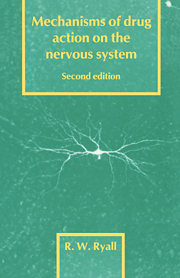4 - Autonomic nervous system
from PERIPHERAL NERVOUS SYSTEM
Published online by Cambridge University Press: 08 October 2009
Summary
The autonomic nervous system (ANS) is an efferent system conveying impulses from the central nervous system to the periphery. It controls the activity of most bodily functions except those of the skeletal muscles which are controlled by the somatic motor system discussed in the preceding chapter. It therefore affects such diverse physiological activities as salivary secretion, sweating, movement and secretions of the gastrointestinal tract, heart rate, calibre of the blood vessels, secretions of the pineal gland, contraction of the urinary bladder and its internal sphincter, penile erection, adrenaline secretion by the adrenal glands, accommodation in the eye and control of pupil diameter. Pharmacological interference with the ANS will therefore lead to widespread effects. A major application of drugs which selectively reduce vasomotor tone is in the treatment of cardiovascular disease.
There are two major divisions of the ANS. The sympathetic division originates from preganglionic nerve cell bodies lying predominantly in the intermediolateral part of the thoracic and upper lumbar regions of the spinal cord. The parasympathetic division originates from nerve cells located in the brain stem and in the sacral spinal cord. Both systems may be distinguished from the skeleto-motor system by the interposition of a peripheral ganglionic synapse between the preganglionic neurone in the CNS and the peripheral, innervated effector organ (Fig. 4.1). The ganglia of the sympathetic division are situated either in the paravertebral chain ganglia or in one of the more distal sympathetic ganglia, such as the cervical sympathetic, stellate, coeliac, inferior mesenteric, or hypogastric ganglia.
- Type
- Chapter
- Information
- Mechanisms of Drug Action on the Nervous System , pp. 43 - 79Publisher: Cambridge University PressPrint publication year: 1989

